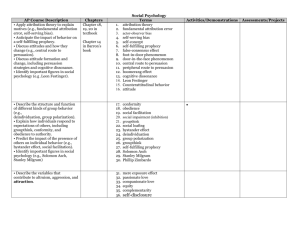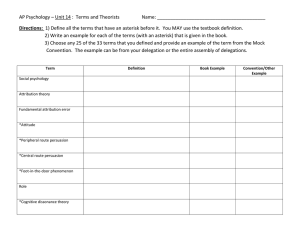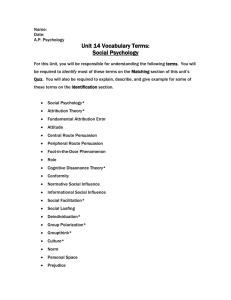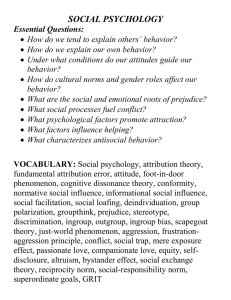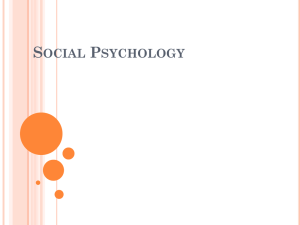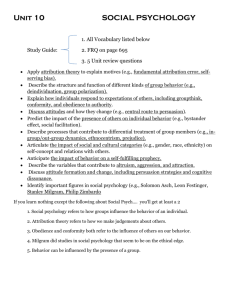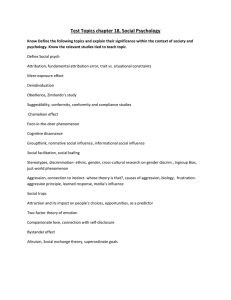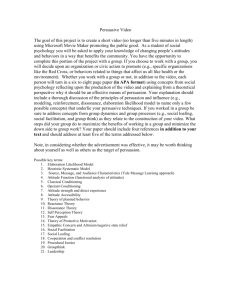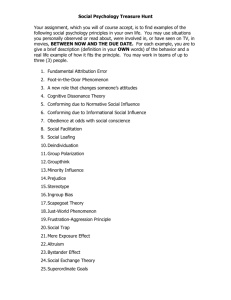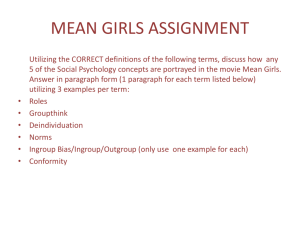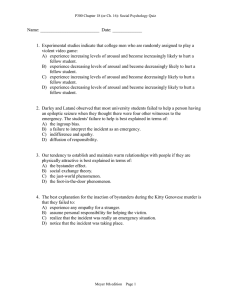Unit 14 PRACTICE TEST with Answers
advertisement
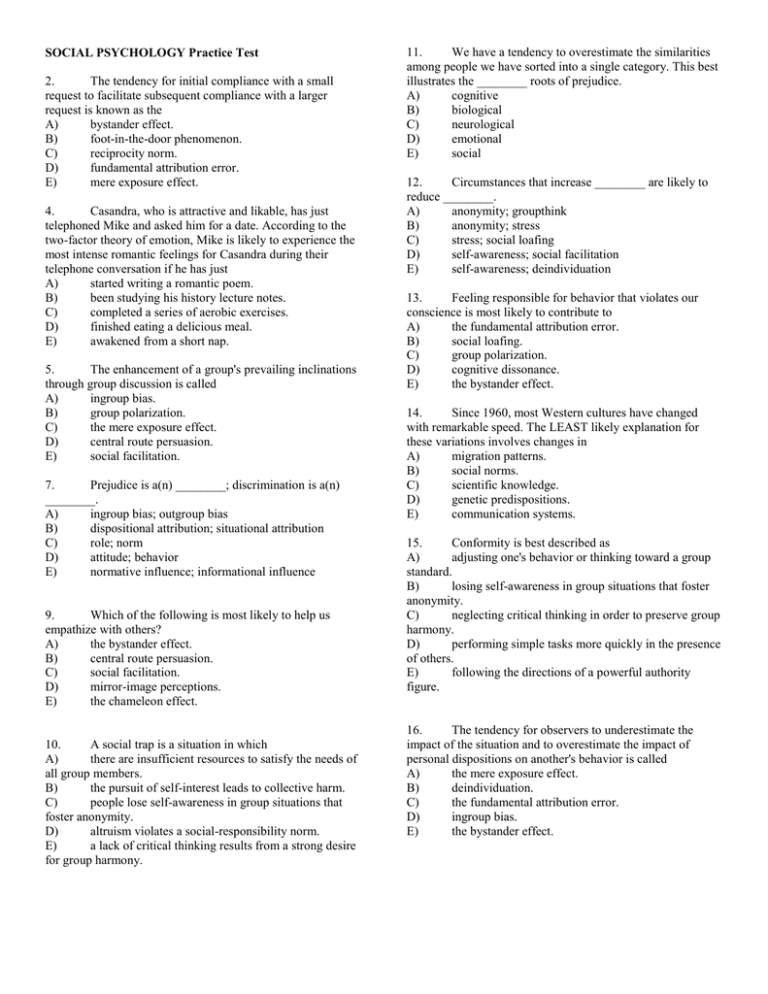
SOCIAL PSYCHOLOGY Practice Test 2. The tendency for initial compliance with a small request to facilitate subsequent compliance with a larger request is known as the A) bystander effect. B) foot-in-the-door phenomenon. C) reciprocity norm. D) fundamental attribution error. E) mere exposure effect. 4. Casandra, who is attractive and likable, has just telephoned Mike and asked him for a date. According to the two-factor theory of emotion, Mike is likely to experience the most intense romantic feelings for Casandra during their telephone conversation if he has just A) started writing a romantic poem. B) been studying his history lecture notes. C) completed a series of aerobic exercises. D) finished eating a delicious meal. E) awakened from a short nap. 5. The enhancement of a group's prevailing inclinations through group discussion is called A) ingroup bias. B) group polarization. C) the mere exposure effect. D) central route persuasion. E) social facilitation. 7. Prejudice is a(n) ________; discrimination is a(n) ________. A) ingroup bias; outgroup bias B) dispositional attribution; situational attribution C) role; norm D) attitude; behavior E) normative influence; informational influence 9. Which of the following is most likely to help us empathize with others? A) the bystander effect. B) central route persuasion. C) social facilitation. D) mirror-image perceptions. E) the chameleon effect. 10. A social trap is a situation in which A) there are insufficient resources to satisfy the needs of all group members. B) the pursuit of self-interest leads to collective harm. C) people lose self-awareness in group situations that foster anonymity. D) altruism violates a social-responsibility norm. E) a lack of critical thinking results from a strong desire for group harmony. 11. We have a tendency to overestimate the similarities among people we have sorted into a single category. This best illustrates the ________ roots of prejudice. A) cognitive B) biological C) neurological D) emotional E) social 12. Circumstances that increase ________ are likely to reduce ________. A) anonymity; groupthink B) anonymity; stress C) stress; social loafing D) self-awareness; social facilitation E) self-awareness; deindividuation 13. Feeling responsible for behavior that violates our conscience is most likely to contribute to A) the fundamental attribution error. B) social loafing. C) group polarization. D) cognitive dissonance. E) the bystander effect. 14. Since 1960, most Western cultures have changed with remarkable speed. The LEAST likely explanation for these variations involves changes in A) migration patterns. B) social norms. C) scientific knowledge. D) genetic predispositions. E) communication systems. 15. Conformity is best described as A) adjusting one's behavior or thinking toward a group standard. B) losing self-awareness in group situations that foster anonymity. C) neglecting critical thinking in order to preserve group harmony. D) performing simple tasks more quickly in the presence of others. E) following the directions of a powerful authority figure. 16. The tendency for observers to underestimate the impact of the situation and to overestimate the impact of personal dispositions on another's behavior is called A) the mere exposure effect. B) deindividuation. C) the fundamental attribution error. D) ingroup bias. E) the bystander effect. 18. If researchers found that people take longer to identify words such as assertive and bold as “strong” when the words are associated with female faces rather than with male faces, this would be considered to illustrate A) a social trap. B) deindividuation. C) the fundamental attribution error. D) implicit prejudice. E) cognitive dissonance. 19. The text defines social psychology as the scientific study of how people ________ one another. A) understand, predict, and control B) observe, understand, and communicate with C) perceive, think about, and talk about D) think about, influence, and relate to E) understand, feel about, and behave toward 22. Opinion change resulting from a thoughtful focus on the content of arguments illustrates A) cognitive dissonance. B) peripheral route persuasion. C) central route persuasion. D) normative social influence. E) social facilitation. 23. Attribution theory was designed to account for A) how people explain others' behavior. B) social facilitation and social loafing. C) the impact of both heredity and environment on social behavior. D) the loss of self-awareness that occurs in group situations. E) the process of revealing intimate aspects of ourselves to others. 26. People heavily exposed to violent pornography are likely to engage in sexually aggressive behaviors that reflect a misleading A) social-responsibility norm. B) hindsight bias. C) social script. D) bystander effect. E) two-factor theory. 30. are A) B) C) D) E) Two social norms that influence altruistic behavior reciprocity and social facilitation. social-responsibility and social exchange. social facilitation and social exchange. reciprocity and social responsibility. similarity and proximity. 34. The tendency to recall faces of one's own race more accurately than faces of other races is called A) the mere exposure effect. B) the other-race effect. C) deindividuation. D) mirror-image perception. E) ingroup bias. Answer Key – Practice Questions Unit 14 2. B 4. C 5. B 7. D 9. E 10. B 11. A 12. 13. 14. 15. 16. 18. 19. 22. 23. 26. 30. 34. E D D A C D D C A C D B
